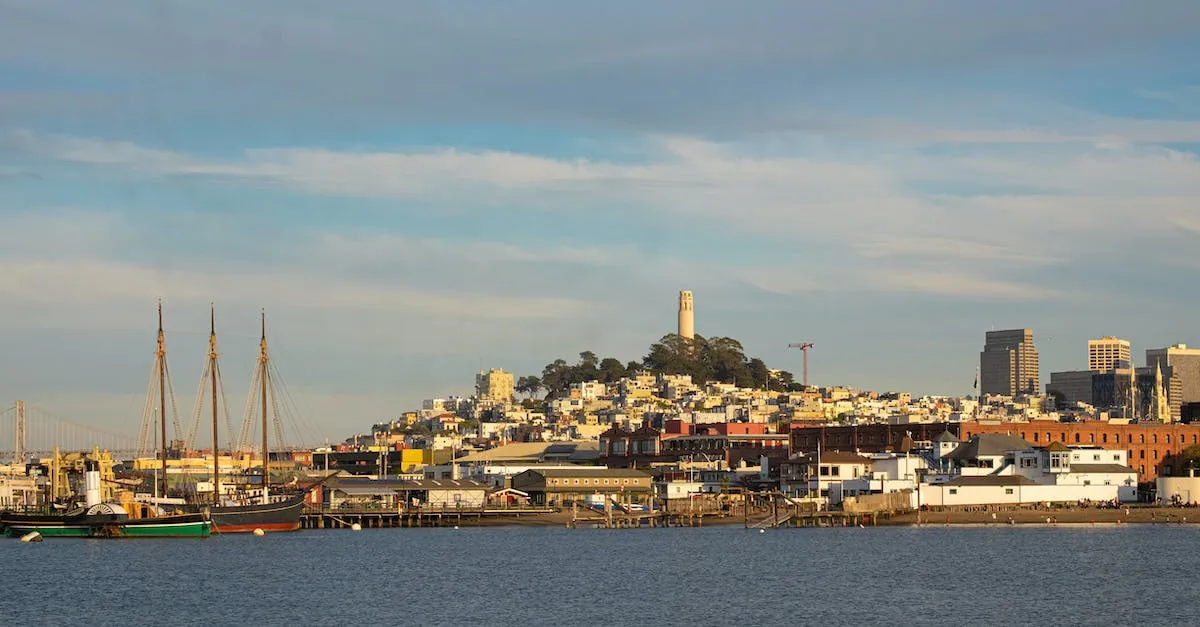Where Exactly Is Central California Located? A Detailed Look At The Region’S Boundaries And Characteristics
For those looking to explore the diverse landscapes and cultures of California, understanding the state’s different regions is key. And for many, one region often shrouded in mystery is Central California.
If you’re short on time, here’s a quick answer to your question: Central California generally refers to the middle portion of the state, between the San Francisco Bay Area/Sacramento Valley and the Los Angeles metropolitan area. It spans the Central Valley and includes cities like Fresno, Bakersfield and Modesto.
In this comprehensive guide, we’ll dive into the details of where exactly Central California is located, how its boundaries are defined, major cities and geographic features found within it, as well as some of the cultural aspects that give this region its distinct flavor.
By the end, you’ll have a clear understanding of what sets apart Central California and what makes it such a vital part of the state.
Geographic Boundaries of Central California
Central California is a region located in the western part of the United States. It is known for its diverse geography, which includes the Central Valley, coastal mountain ranges, and major cities and counties. Let’s take a closer look at the boundaries and characteristics of this fascinating region.
The Central Valley
The Central Valley is a vast, fertile plain that stretches for approximately 450 miles in the heart of California. It is surrounded by the Sierra Nevada Mountains to the east and the Coastal Mountain Ranges to the west.
The valley is known for its rich agricultural production, with crops such as fruits, vegetables, and nuts thriving in its fertile soil. It is also home to diverse wildlife and serves as an important habitat for various bird species.
Coastal Mountain Ranges
The Coastal Mountain Ranges flank the western edge of Central California, running parallel to the Pacific Ocean. These mountain ranges, including the Santa Lucia Mountains and the Santa Cruz Mountains, offer stunning panoramic views of the coastline and provide a natural barrier between the Pacific Ocean and the Central Valley.
The rugged terrain of the Coastal Mountain Ranges attracts outdoor enthusiasts who enjoy hiking, camping, and exploring the region’s natural beauty.
Major Cities and Counties
Central California is home to several major cities and counties that contribute to the region’s economic and cultural significance. Fresno, the largest city in Central California, serves as a hub for agriculture and is known for its vibrant arts and culture scene.
Other notable cities in the region include Bakersfield, Modesto, and Stockton. These cities offer a range of amenities, including museums, theaters, and recreational opportunities.
When it comes to counties, Central California encompasses a vast area, including Fresno County, Kern County, and San Joaquin County, among others. These counties are known for their agricultural productivity, natural beauty, and diverse communities.
Each county has its own unique charm and attractions, making Central California a region worth exploring.
For more information about Central California’s geographic boundaries and characteristics, you can visit www.visitcentralvalley.com. This website offers a wealth of resources and insights about the region, including travel guides, maps, and upcoming events.
Defining Central California’s Northern Border
When it comes to defining Central California’s northern border, there are a few key factors to consider. One commonly accepted cutoff point is the San Francisco Bay Area. This bustling region, known for its iconic Golden Gate Bridge and vibrant tech industry, is often seen as the dividing line between Northern and Central California.
With its unique blend of urban and natural landscapes, the Bay Area serves as a distinct boundary that separates the two regions.
San Francisco Bay Area As the Cutoff Point
The San Francisco Bay Area encompasses several counties including San Francisco, San Mateo, Alameda, Contra Costa, Marin, and Santa Clara. These counties form a diverse and dynamic metropolitan area that is home to millions of residents.
The region’s economic and cultural significance, as well as its geographical location, make it a logical choice for establishing Central California’s northern border.
Stretching from the iconic city of San Francisco in the north to the innovative hub of Silicon Valley in the south, the Bay Area offers a wide range of attractions and opportunities. From the bustling streets of downtown San Francisco to the serene beauty of Marin County’s coastal landscapes, the Bay Area is a vibrant and distinct region that sets Central California apart from its northern neighbors.
Sacramento Valley Excluded
While the San Francisco Bay Area serves as a clear cutoff point for Central California’s northern border, it’s important to note that the region does not encompass the entirety of the state’s northernmost areas.
One notable area that falls outside the boundaries of Central California is the Sacramento Valley.
The Sacramento Valley, located north of the Bay Area, is a fertile agricultural region that stretches from the northern tip of the Sacramento-San Joaquin Delta to the southern edge of the Cascade Range. It is known for its vast farmlands, including rice paddies, orchards, and vineyards.
The region’s central feature is the Sacramento River, which flows southward through the valley before joining the San Joaquin River.
While the Sacramento Valley shares some similarities with Central California, such as its agricultural significance, it is generally considered part of the larger Northern California region. Its distinct characteristics and geographical separation from the Bay Area make it more aligned with the northernmost areas of the state.
Defining the Southern Border
When it comes to Central California, defining its southern border can be a topic of debate. However, there are a few key factors that can help us understand where this border lies.
Metro LA Generally Seen as Separate
One common perspective is that the southern border of Central California is marked by the metropolitan area of Los Angeles. With its sprawling urban landscape and distinct cultural identity, many people consider Metro LA to be a separate region from Central California.
This perception is reinforced by the fact that Metro LA is geographically separated from Central California by the Santa Monica Mountains and the San Gabriel Mountains. These mountain ranges create a natural barrier that further distinguishes the two regions.
It’s important to note that while Metro LA may be seen as separate from Central California, it still plays a significant role in the state’s economy and culture. With its vibrant entertainment industry, bustling port, and diverse population, Metro LA is undoubtedly a prominent part of California’s overall landscape.
The Tehachapi Mountains as a Natural Border
Another perspective on the southern border of Central California is the presence of the Tehachapi Mountains. This mountain range, located just north of Metro LA, serves as a natural barrier between the southern part of the state and the Central Valley.
The Tehachapi Mountains not only provide a physical boundary but also have a significant impact on climate and geography. They separate the coastal influences of Southern California from the more inland characteristics of Central California.
As you move north from the Tehachapi Mountains, you’ll notice a transition in the landscape. The flat, fertile farmland of the Central Valley begins to dominate, giving Central California its characteristic agricultural identity.
It’s worth mentioning that the precise location of Central California’s southern border can vary depending on who you ask. Some may include parts of Metro LA in the region, while others may draw the line further south. Ultimately, it’s a matter of perspective and interpretation.
To learn more about the boundaries and characteristics of Central California, you can visit https://www.visitcentralvalley.com/ for a comprehensive guide to the region.
Unique Geographic Features of Central California
Mediterranean Climate
One of the unique geographic features of Central California is its Mediterranean climate. This region enjoys mild, wet winters and warm, dry summers, similar to the climate found in countries bordering the Mediterranean Sea.
The combination of cool ocean currents and the coastal mountain ranges helps create this pleasant climate. The moderate temperatures make Central California an ideal place for agriculture, with crops such as grapes, olives, and citrus fruits thriving in the region.
Diverse Topography from Mountains to Desert
Central California boasts a diverse topography that encompasses everything from majestic mountains to sprawling deserts. The region is home to the Sierra Nevada mountain range, which includes some of the highest peaks in the United States.
Mount Whitney, standing at an impressive 14,505 feet, is the tallest mountain in the contiguous United States and is located in Central California.
In addition to mountains, Central California also features a stunning coastline along the Pacific Ocean. The Big Sur coastline is known for its breathtaking cliffs and rugged beauty, attracting visitors from all over the world.
The region also includes the iconic Monterey Bay, famous for its abundant marine life and picturesque coastal towns.
As you move inland, Central California transitions into the San Joaquin Valley, which is known as the breadbasket of the state. This fertile valley is home to vast agricultural fields, producing a significant portion of the nation’s food supply.
From fruits and vegetables to dairy and nuts, the San Joaquin Valley plays a vital role in sustaining California’s agricultural industry.
Further east, Central California transitions into the Mojave Desert, a vast expanse of arid land characterized by its unique desert ecosystem. The Mojave Desert is home to Joshua Tree National Park, a popular destination for outdoor enthusiasts and nature lovers.
Major Cities and Regions Within Central California
Fresno – Agricultural Hub
Fresno, located in the heart of Central California, is known as the agricultural hub of the region. The city sits in Fresno County, which is the leading agricultural county in the United States. With its fertile soil and favorable climate, Fresno County produces a wide variety of crops, including grapes, almonds, tomatoes, and citrus fruits.
The abundance of agricultural resources in Fresno has contributed to the city’s economic growth and has made it a key player in the state’s agricultural industry.
Bakersfield and Kern County
Bakersfield is another major city in Central California, located in Kern County. Kern County is known for its significant oil production, making it one of the top oil-producing regions in the country. The oil industry has played a crucial role in the economic development of Bakersfield and surrounding areas.
In addition to oil, Kern County is also home to a thriving agricultural sector, with crops like cotton, almonds, and citrus fruits being grown in abundance. Bakersfield and Kern County offer a unique blend of natural resources and economic opportunities.
Modesto and Stanislaus County
Modesto, situated in Stanislaus County, is a vibrant city in Central California with a rich agricultural heritage. The county is known for its production of dairy products, poultry, and nuts. Modesto, in particular, is famous for its almond orchards and is often referred to as the “Almond Capital of the World.”
The region’s fertile farmland, combined with a favorable climate, has made Stanislaus County a key player in California’s agricultural industry. Modesto serves as a center for agricultural processing and distribution, contributing to the economic prosperity of the region.
Merced – Gateway to Yosemite
Merced, located in Merced County, is often considered the gateway to Yosemite National Park. This picturesque city offers easy access to one of the most iconic national parks in the United States. Merced County is also an agricultural powerhouse, specializing in dairy farming, poultry production, and almond cultivation.
The county’s proximity to Yosemite attracts tourists from all over the world, boosting the local economy and making Merced an important destination for nature enthusiasts.
Cultural Aspects and Local Identity
Central California is not only geographically diverse but also culturally vibrant. The region’s unique blend of influences has shaped its local identity, making it a fascinating place to explore. From the strong Hispanic influence in the south to its agricultural roots and thriving country music scene, Central California offers a rich cultural tapestry for residents and visitors alike.
Hispanic Influence in the South
The southern part of Central California is heavily influenced by Hispanic culture. With a significant population of Mexican Americans, this area is known for its vibrant festivals, delicious cuisine, and colorful traditions.
From the annual Cinco de Mayo celebrations to the lively mariachi music that fills the air, the Hispanic influence is deeply ingrained in the fabric of the local community. It is not uncommon to hear Spanish spoken in the streets and see shops selling authentic Mexican goods.
This cultural richness adds a unique flavor to the region and contributes to its diversity and inclusivity.
Agricultural Roots
Central California has a strong agricultural heritage, and this is evident in its landscape and economy. The region is often referred to as the “breadbasket of the world” due to its extensive farming activities.
From vast fields of fruits and vegetables to dairy farms and vineyards, agriculture plays a vital role in shaping the local identity. The hardworking farmers and farmworkers who toil the land have become synonymous with Central California, and their dedication and perseverance are commendable.
Visitors can explore farmers’ markets, take farm tours, and even participate in harvest festivals to get a firsthand experience of the region’s agricultural roots.
Country Music Scene
Surprisingly, Central California boasts a thriving country music scene that attracts both local talent and renowned artists from across the country. The region has a deep appreciation for this genre, and it is not uncommon to find live country music performances in local bars, clubs, and music venues.
Central California has produced its fair share of country music stars, and their success has further contributed to the region’s identity as a hub for country music enthusiasts. Whether you’re a fan of classic country or enjoy the modern sounds of today’s country music, Central California offers a vibrant country music scene that is sure to get your boots tapping and your heart singing.
Conclusion
As we’ve explored, Central California has geographic boundaries including the Central Valley, Sierra Nevada and Coast Ranges. Major urban centers like Fresno, Bakersfield and Modesto anchor the region. Culturally, Central California has developed its own identity with Hispanic influences, agricultural roots and country music.
While definitions aren’t always precise, most consider the northern border to end around Stockton and the Bay Area, while Southern California begins on the other side of the Tehachapi Mountains. Within these boundaries lie diverse landscapes from mountains to desert.
Hopefully this guide has helped crystallize what makes Central California a distinct region. Wherever your California travels take you, understanding a bit about the state’s core central region will give you insight into an essential piece of the diverse fabric that makes up the Golden State.








